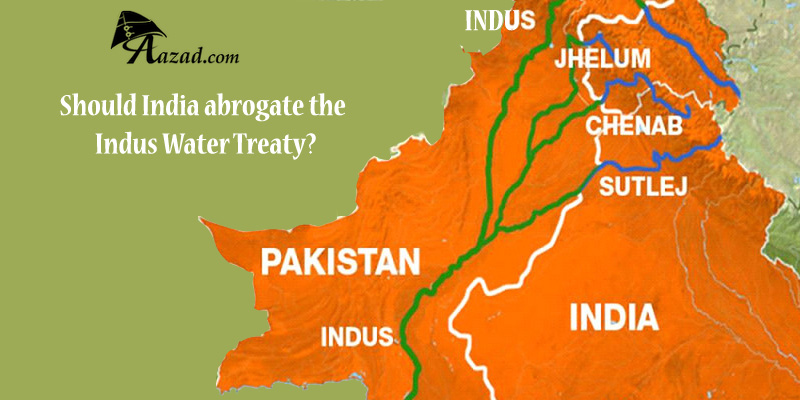- ●Breakthroughs in Prostate Cancer Treatment: What Every Patient Should Know
- ●Ovarian Cancer: The Silent Disease Women Cannot Ignore
- ●Children and Blood Cancer: Why Awareness is Crucial
- ●Women in Aviation India commences the celebration of 10th Girls in Aviation Day
- ●2025 Announcement, Appointment of New Board to Lead Hindustan National Glass & Industries Ltd
Indus River: India's Lethal Weapon Against Pakistan

Pakistan has been continuously sending terrorists to India to kill innocent people. Since Pakistan has lost all the wars against India as also a major chunk of its land (East Pakistan) which is now called Bangladesh, Pakistan is hell bent on taking revenge by occupying the Indian state of Jammu and Kashmir. It is difficult for India to declare a full fledged war because if that happens, Pakistan being an irresponsible terrorist state, will definitely be the first one to use Nuclear Weapons, though its very existence will be at risk because if India retaliates, Pakistan will be annihilated. Selective strikes on terror camps in Pakistan will risk a full fledged war therefore India has to exercise other options to cause maximum damage to Pakistan. One such measure that India has is abrogating the Indus Water Treaty. If India decides to do so, Pakistan will die dry because Indus River supplies water to most of Pakistan. But that ain't an easy thing for India to do. Let us evaluate.
Indus river originates in China and then enters India - running across Ladakh region of Jammu and Kashmir. Indus river then enters Pakistan (Gilgit region) before taking a southward direction and flowing along the entire length of Punjab (Pakistan) to merge with the Arabian Sea near the port city of Karachi.
- Indus is the longest river in Pakistan.
- With a length of 3180 KM, Indus (Sindhu) River is longer than Ganga (2525KM) and one of the longest rivers in Asia. It is the 21st largest river in the world in terms of annual flow.
The main tributaries (a river or stream flowing into a larger river) of Indus River are Chenab, Jhelum, Ravi, Beas and Sutlej.
- Chenab originates in Lahaul and Spiti district of Himachal Pradesh, India, then flows into Jammu and Kashmir before entering Pakistan.
- The Jhelum river starts from Verinag in the Indian State of Jammu and Kashmir, and then enters Pakistani Occupied Kashmir (POK).
- The Beas River starts in Himachal Pradesh, India and flows for some 470 KM (290 mi) to the Sutlej River in the Indian state of Punjab
- The Sutlej River originates in Tibet, China and then enters the Indian state of Himachal Pradesh before
- The Ravi river originates in Himachal Pradesh, India and then moves to Pakistan.
All the 5 rivers (Chenab, Jhelum, Ravi, Beas and Sutlej) join the Indus River in Mithankot, Pakistan.
The Indus river flows along the entire length of Punjab, Pakistan to merge with the Arabian Sea near the port city of Karachi. Indus river is strategically a vital resource for Pakistan. After India and Pakistan got independence, the use of waters ad its 4 tributaries became a bone of contention between the two countries.
Pakistan was suspicious of India. It feared India would build dams and cut the supply of flowing water to Pakistan. The relationship between the two countries went from bad to worse back in 1951. In 1951, David E Lilienthal, former chairman of Tennessee Valley Authority visited India and Pakistan and wrote an article with suggestions that Indus Basin be treated, exploited and developed as a single unit.
The World Bank started mediating between India and Pakistan in 1952 over the Indus River water and the Indus Waters Treaty was signed on September 19, 1960 by the then Prime Minister Jawaharlal Nehru and Pakistan's President Ayub Khan.
According to the Indus Water Treaty, Beas, Ravi and Sutlej rivers are to be governed by India, while, Indus, Chenab and Jhelum are to be taken care by Pakistan.
Since Indus flows from India, the country is allowed to use 20 per cent of its water for irrigation, power generation and transport purposes.
What If India Decides to Build Dams as also change the course of the Indus River?
If that happens, Pakistan will face a major setback. Most of its land will be dry because Indus is a major source of water for Pakistan.
India may restart the Tulbul Project:
India had started constructing of a 439-feet-long and 40-feet-wide barrage at the mouth of the Wular Lake to ensure the flow of water in winter to 4,000 cusecs. To facilitate trade, tourism and employment of local population, India envisages controlled release of water from the lake during the lean season months of October to February to facilitate year-round navigation.
India unilaterally suspended the Tulbul project (Islamabad calls it Wullar Barrage) in 1987 after Pakistan protested. Pakistan said "controlled flow of water to the Jhelum" can harm parts of Pakistan. Pakistan threatened to move the International Arbitral Court in 1986 and that lead to the Indian Govt. suspending the project.
Narendra Modi government's decision at a high-level meeting recently to "review" the suspension of construction on the Tulbul navigation project has given it "a geo-strategic edge" over their arch rival Pakistan.
What would be the Implications of restarting the Tulbul Project?
- India gets to control Jhelum water, impact Pakistan agriculture
- Project can create problems for Pakistan's triple-canal project that connects Jhelum-Chenab with Upper Bari Doab Canal
- With a barrage, India controls release of water into Jhelum, which could trigger a flood or drought in POK and Pakistan. Serious implications for agriculture in Pakistan
Can India Abrogate the Indus Water Treaty to teach Pakistan a lesson?
- Yes we can do that. Article 62 of the Vienna Convention on the Law of Treaties allows any country to revoke a treaty on reasonabe grounds. India can cite Pakistani sponsored terrorism as a reason for canceling the treaty.
- India has to keep in mind that China beings its hostile neighbour and a supporter of Pakistan will misuse its power to block Indus and Brahmaputra water to India. Doing so would not affect India as much as India blocking the water of Indus to Pakistan. Even if China does block the flow of Indus River, 5 of Indus River's tributaries viz. Chenab, Jhelum, Ravi, Beas and Sutlej start from India and India can change the course of these rivers and prevent them from flowing into Pakistan and this will cause a major damage to Pakistan.




